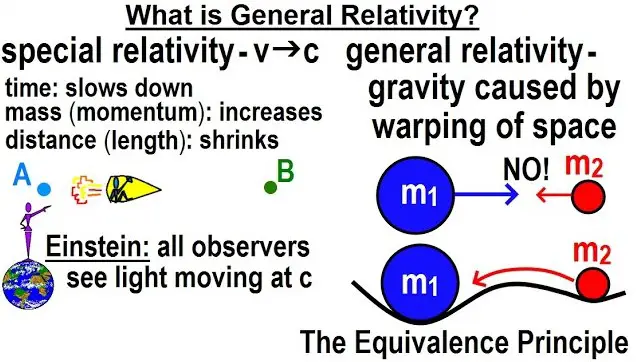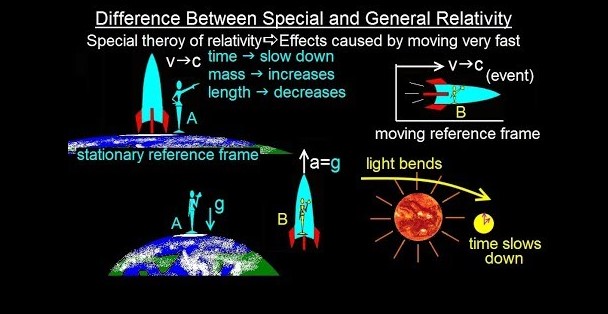Relativity, in the context of physics, refers to two groundbreaking theories proposed by Albert Einstein in the early 20th century. These theories revolutionized our understanding of space, time, and gravity, challenging the Newtonian mechanics that had dominated the scientific community for centuries. Einstein’s insights into the fabric of the universe have had profound implications, not just for theoretical physics but for our everyday understanding of how the universe operates.
The difference between General and Special Relativity lies primarily in their scope and the phenomena they explain. Special Relativity deals with the physics of objects in uniform motion and introduces concepts like time dilation and length contraction. In contrast, General Relativity expands on this, describing the gravity-driven curvature of spacetime around massive objects, applicable to scenarios involving accelerated motion and gravitational fields.
General Relativity and Special Relativity together form the cornerstone of modern physics, offering explanations for everything from the behavior of particles racing at near-light speeds to the gravitational pull of black holes warping the fabric of spacetime. These theories underscore the interconnectivity of space and time, mass and energy, and provide the foundation for understanding the vast, dynamic cosmos.

Relativity Basics
Historical Context
Before Einstein’s groundbreaking work, physics was largely dominated by Newtonian mechanics, which described the motions of objects and the forces acting upon them. This framework, built on the principles set forth by Isaac Newton in the 17th century, explained most of the physical phenomena observed in everyday life. However, as experiments became more precise and scientists began to explore the realms of the very fast and the very massive, Newton’s laws showed limitations. This led to a period of significant scientific upheaval at the turn of the 20th century, setting the stage for Albert Einstein’s revolutionary theories.
Key Principles
Relativity, both General and Special, rests on two main principles. First, the Principle of Relativity asserts that the laws of physics are the same for all observers, regardless of their relative motion. Second, the constancy of the speed of light states that the speed of light in a vacuum is the same for all observers, no matter their motion relative to the light source. These principles challenge conventional notions of absolute time and space, introducing a framework where time and space are interwoven and relative.
Special Relativity Explained
Time Dilation
One of the most fascinating consequences of Special Relativity is time dilation, which reveals that time does not pass at a fixed rate for all observers. Instead, time slows down for objects moving at high speeds relative to an observer. This effect becomes more pronounced as the object’s speed approaches the speed of light. For instance, astronauts traveling in a spacecraft at high velocities would age slower than people on Earth.
Length Contraction
Similarly, length contraction describes how objects in motion appear shorter in the direction of motion to an observer at rest. This effect, like time dilation, becomes significant at speeds close to the speed of light. Length contraction and time dilation are intertwined phenomena that stem from the constancy of the speed of light for all observers.
Mass-Energy Equivalence
Perhaps the most famous equation to emerge from Special Relativity is E=mc², where E is energy, m is mass, and c is the speed of light in a vacuum. This equation signifies that mass and energy are two sides of the same coin, capable of being converted into each other. It implies that a small amount of mass can be converted into a vast amount of energy, explaining the tremendous energy released in nuclear reactions.
General Relativity Simplified
Gravity as Geometry
General Relativity further expands the concept of relativity by explaining gravity not as a force acting at a distance, as Newton proposed, but as the curvature of spacetime caused by mass and energy. This curvature guides the motion of objects, leading to what we perceive as gravitational attraction. The more massive an object, the more it warps the fabric of spacetime around it.
Acceleration and Gravity
Einstein’s principle of equivalence states that the effects of acceleration are indistinguishable from those of gravity. This means that being in an accelerating spaceship without windows, one would not be able to tell whether the force felt is due to acceleration or gravitational pull from an external mass. This equivalence was a crucial step in developing General Relativity, linking accelerated motion with the geometry of spacetime.
Black Holes and Cosmology
One of the most intriguing predictions of General Relativity is the existence of black holes, regions of spacetime where the curvature becomes so extreme that not even light can escape. This theory also provides the framework for cosmology, the study of the universe’s structure and evolution, including the Big Bang theory and the expansion of the universe. General Relativity’s implications reach far beyond our solar system, offering insights into the fundamental structure of the cosmos.
Core Differences
Conceptual Framework
Special Relativity and General Relativity rest on different foundations. Special Relativity applies to objects moving at constant speeds in straight lines, showing how time and space are perceived differently by observers in relative motion. It emphasizes the invariance of the speed of light and the relativity of simultaneity. In contrast, General Relativity deals with gravity, describing it as the curvature of spacetime caused by mass and energy. This theory applies to all scenarios, including non-linear motion and accelerated frames of reference, providing a universal explanation of gravitational phenomena.
Applicability
Special Relativity is most relevant in scenarios involving high speeds close to the speed of light but without significant gravitational fields. This includes particle physics and electromagnetism. General Relativity is crucial when dealing with massive objects and strong gravitational fields, such as in cosmology, astrophysics, and the study of black holes and the universe’s expansion.
Mathematical Complexity
The mathematics behind General Relativity is more complex than that of Special Relativity. Special Relativity primarily uses algebra and basic calculus, accessible to undergraduates in physics. General Relativity, however, relies on tensor calculus and differential geometry, requiring a higher level of mathematical sophistication and understanding.
Experimental Evidence
Tests of Special Relativity
Several key experiments validate Special Relativity. The Michelson-Morley experiment debunked the ether theory, aligning with Special Relativity’s postulate that the speed of light is constant. Time dilation has been directly observed in particles at particle accelerators and in atomic clocks aboard satellites, confirming Special Relativity’s predictions.
Verifying General Relativity
General Relativity has been confirmed through various observations. The bending of light by gravity was observed during the solar eclipse of 1919, matching Einstein’s predictions. The precise orbit of Mercury and the gravitational redshift of light in strong gravitational fields further corroborate General Relativity. More recently, the detection of gravitational waves from colliding black holes by LIGO provided direct evidence of spacetime ripples predicted by the theory.
Impact on Modern Physics
Technology Influenced by Relativity
Relativity has profound implications for technology. GPS systems, for example, must account for both the effects of Special and General Relativity to achieve precise location tracking. Atomic clocks, which are fundamental to the functioning of these systems, demonstrate the practical applications of time dilation.
Theoretical Developments
Relativity has influenced other areas of physics, paving the way for modern quantum field theory and the Standard Model of particle physics. It also plays a crucial role in the ongoing search for a theory of quantum gravity, aiming to reconcile the principles of quantum mechanics with General Relativity.
Future Directions
Unanswered Questions
Despite its successes, relativity leaves some questions unanswered. These include the nature of dark matter and dark energy, the singularity at the center of black holes, and the correct interpretation of time before the Big Bang.
The Quest for a Unified Theory
Efforts to reconcile relativity with quantum mechanics have led to several proposed theories of quantum gravity, such as string theory and loop quantum gravity. These endeavors aim to describe all fundamental forces and particles within a single, coherent framework, solving the incompatibilities between the theories that describe the very large (General Relativity) and the very small (quantum mechanics).
FAQs
What is Special Relativity?
Special Relativity is a theory proposed by Albert Einstein that addresses the physics of objects in uniform motion. It introduces groundbreaking concepts such as time dilation, where time slows down for objects moving at high speeds, and length contraction, where objects in motion are observed to shorten. It fundamentally changed our understanding of time and space, asserting that the laws of physics are the same for all non-accelerating observers.
How does General Relativity differ from Special Relativity?
General Relativity is an extension of Special Relativity that includes the effect of gravity on the fabric of spacetime. While Special Relativity applies to uniform motion without considering gravitational effects, General Relativity describes how matter and energy distort spacetime, leading to gravity. It provides the framework for understanding cosmic phenomena such as black holes, gravitational waves, and the expansion of the universe.
Why are General and Special Relativity important?
General and Special Relativity are crucial for our understanding of the universe. They explain phenomena that cannot be described by classical physics, such as the behavior of light around massive objects and the time experienced by astronauts in space. These theories are not only fundamental to the field of physics, but they also have practical applications in technologies like GPS systems, which require adjustments for relativistic effects to maintain accuracy.
Conclusion
General and Special Relativity stand as monumental achievements in the realm of physics, offering profound insights into the nature of the universe. Together, they have expanded our understanding of how time, space, and gravity interact, guiding the way we perceive everything from the smallest particles to the largest cosmic structures. Their implications stretch beyond theoretical physics, influencing technology, philosophy, and our very conception of reality.
These theories, while complex, are essential for anyone seeking to grasp the fundamental truths of our universe. As we continue to explore and challenge the limits of our understanding, General and Special Relativity remain beacons of scientific achievement, highlighting the enduring quest for knowledge and the power of human curiosity.

